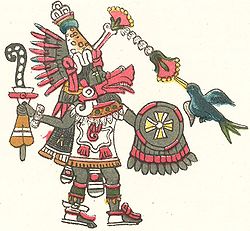Fingerprints of the Gods
Fingerprints of the Gods: The Evidence of Earth's Lost Civilization is a 1995
The book was followed by Magicians of the Gods.[4]
Thesis

Hancock argues for a civilisation centered on
- creation myths describing deities like:
- Osiris, Thoth (Egypt)
- Quetzalcoatl (Mesoamerica)
- Viracocha (Andes)
- a range of alternative archaeology", including Von Däniken's Chariots of the Gods?.[6] Von Däniken suggested that it provides evidence of an extraterrestrial civilisation, whereas Hancock does not argue for "ancient astronauts";[3]he proposes Atlantis as the origin of a lost civilisation.
Hancock suggests that in 10,450 BC, a major
Reception
Members of the scholarly and scientific community have described the proposals put forward in the book as pseudoscience and pseudoarchaeology.[8][9]
Canadian author
Kenneth Feder said that the book reads like the "Victorian travelogue" of a writer untrained in archeology, who credits a mysterious white people for the achievements of the ancient civilizations he visits, Hancock notably referring to the Maya as "jungle-dwelling Indians" who could not possibly come up with a sophisticated calendar. Feder sees Hancock's synthesis of a variety of fringe writers such as Ignatius Donnelly, Charles Hapgood, Arthur Posnansky, Robert Bauval and Anthony West "very hard to swallow, indeed."[10]
Fingerprints of the Gods has been translated into 27 languages and is estimated to have sold five million copies around the world.[11]
Hancock responded to some of his critics with an updated edition of the book published in 2001 with a new introduction and new appendices, Fingerprints of the Gods: The Quest Continues.[non-primary source needed]
Influence
Fingerprints of the Gods was cited as an inspiration for the 2009 disaster film 2012.[12] In a November 2009 interview with the London magazine Time Out, the film's director Roland Emmerich stated, "I always wanted to do a biblical flood movie, but I never felt I had the hook. I first read about the Earth's crust displacement theory in Graham Hancock's Fingerprints of the Gods."[13]
In the extras of the Blu-ray 10,000 BC, the director Emmerich and his co-writer Harald Kloser said that they had found inspiration in the same book.[14]
References
- ^ Fagan 2006, pp. xvi.
- ^ Killgrove, Kristina (3 September 2015). "What Archaeologists Really Think About Ancient Aliens, Lost Colonies, And Fingerprints Of The Gods". Forbes.
- ^ a b Moss, Stephen (6 February 2002). "Castles in the sea". The Guardian. Retrieved 28 November 2009.
- ^ "Religion, Spirituality and Faith Books - Best Sellers - Books - Dec. 13, 2015 - the New York Times". The New York Times.
- ^ Tiwanaku: Spiritual and Political Centre of the Tiwanaku Culture UNESCO.
- ^ a b Pringle, Heather, The Master Plan: Himmler's Scholars and the Holocaust (2006), Fourth Estate, London: p.310
- ^ Hapgood, Charles Hutchins; Earth's Shifting Crust: A Key to Some Basic Problems of Earth Science (Pantheon Books, 1958; foreword by Albert Einstein)
- ISBN 978-0-415-30593-8p. 28
- ISBN 978-0-8248-3219-3p. 128
- S2CID 164241758– via Cambridge.org.
- ^ "Graham Hancock Biography". GrahamHancock.com. Retrieved 26 November 2009.
- ^ "2012 (2009) – Credit List" (PDF). chicagoscifi.com. Archived from the original (PDF) on 15 February 2010. Retrieved 25 November 2009.
- Time Out. Archived from the originalon 16 November 2009. Retrieved 25 November 2009.
- ^ (in Italian) Tambone, Alessio (15 September 2008). "Versione Stampabile _ Blu-ray 10.000 AC". AV Magazine (in Italian). Retrieved 28 July 2013.
Works cited
- ISBN 978-0-415-30592-1.
Further reading
- Brass, M. (2002). "Tracing Graham Hancock's Shifting Cataclysm". Skeptical Inquirer. 26 (4): 45–49. Archived from the original on 26 April 2010.
- Edlin, D. (n.d.). "The Gentle Art of Myth Management". In the Hall of Ma’at. Retrieved 14 November 2022.
- Fagan, G. (n.d.). "Tiwanaku: Alternative History in Action". In the Hall of Ma’at. Retrieved 14 November 2022.
- Fagan, G. (n.d.). "An Answer to Graham Hancock". In the Hall of Ma’at. Retrieved 14 November 2022.
- Hancock, Graham (n.d.). "Fingerprints of the Gods - Evidence of Earth's Lost Civilization (1995)". GrahamHancock.com. Retrieved 14 November 2022.
- Heinrich, P. (n.d.). "Wild Side of Geoarchaeology". In the Hall of Ma’at. Retrieved 14 November 2022. Comments on Hancock's views of geology presented in a series of articles.
- Malek, J. (1996). "Fingerprints of the Gods: A Review". Discussions in Egyptology. 34: 135–142. Retrieved 14 November 2022 – via In the Hall of Ma’at.
